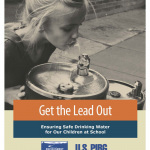Get the Lead Out 2017
Ensuring Safe Drinking Water for Our Children at School
Our children need safe drinking water — especially at school where they go to learn and play each day. Unfortunately, lead is contaminating drinking water at schools and pre-schools across the country. That’s why we’re working to Get the Lead Out.
Downloads
U.S. PIRG Education Fund and Environment America Research & Policy Center

Over the past two years, the tragedy of Flint, Michigan has stunned the nation. We watched the drinking water of an entire city become contaminated with lead. And now we know this toxic threat extends well beyond Flint to communities across the country. In fact, test results now show that lead is even contaminating drinking water in schools and pre-schools — flowing from thousands of fountains and faucets where our kids drink water every day.
Lead is highly toxic, especially for children
A potent neurotoxin, lead affects how our children learn, grow, and behave. According to EPA, “In children, low levels of [lead] exposure have been linked to damage to the central and peripheral nervous system, learning disabilities, shorter stature, impaired hearing, and impaired formation and function of blood cells.”[i] In fact, medical researchers estimate that more than 24 million children in America will lose IQ points due to low levels of lead.[ii]
Lead in the drinking water at school
Even the limited available data shows drinking water laced with lead at schools and early childhood programs across the country.
The threat of lead in schools’ water affects not only big cites but also suburban and rural communities. Tests have documented lead tainted water in schools in Cherry Hill, NJ[iii], Yarmouth, ME[iv], and several other school districts in upstate New York[v] and suburban communities in Illinois.[vi]
Sometimes, the levels of lead are exceedingly high. For example, one drinking water fountain at a Montessori school in Cleveland had 1,560 parts per billion.[vii] A school in the Chicago suburbs had lead at 212 times the federal standard.[viii] Leicester Memorial Elementary in Massachusetts had a tap that tested at 22,400 ppb.[ix]
A pervasive threat to our children’s health
In all likelihood, these confirmed cases of lead in schools’ water are just the tip of the iceberg. Most schools have at least some lead in their pipes, plumbing, or fixtures. And where there is lead, there is risk of contamination.
Massachusetts is one of the few states to test extensively and publish all results showing any level of lead in schools’ water. The results are shocking: nearly half of the tests (49.7 percent) conducted at Bay State schools so far have found some level of lead in the water, according to data published by the state as of January 6, 2017.
Time to Get the Lead Out
Given these facts, the only way to ensure safe drinking water for our children is simply to “get the lead out” of our schools and pre-schools. This involves proactively removing lead-bearing parts from schools’ drinking water systems – from service lines to faucets and fixtures – and installing filters certified to remove lead at every tap used for drinking or cooking.
What you can do
Contact your school and ask whether it has lead pipes or plumbing. Ask if the water has been tested for lead and to see all the results. Sometimes schools only report levels of lead in water above 15 parts per billion, but there is no safe level of lead in drinking water, especially for our children.
In addition, we’re calling on all states to “get the lead out” of schools drinking water. Please urge your governor to take strong action to protect our children’s health.
[i] U.S. Environmental Protection Agency, “Basic Information about Lead in Drinking Water,” EPA.gov, updated December 2016, accessible at https://www.epa.gov/ground-water-and-drinking-water/basic-information-about-lead-drinking-water.
[ii] American Academy of Pediatrics, Prevention of Childhood Lead Toxicity, (policy statement), July 2016, page 4, available at http://pediatrics.aappublications.org/content/pediatrics/early/2016/06/16/peds.2016-1493.full.pdf.
[iii]Jim Walsh, “Lead level high in Cherry Hill classroom,” Courier-Post, December 7, 2016, accessible at http://www.courierpostonline.com/story/news/local/south-jersey/2016/12/07/cherry-hill-lead-water/95095118/.
[iv] Gillian Graham, “Excess lead in Yarmouth schools’ water sparks call for testing at all schools,” Portland Press Herald, September 2, 2016, accessible at http://www.pressherald.com/2016/09/01/excess-lead-in-water-sparks-call-for-testing-at-all-schools/.
[v] See Dan Herbeck, Jane Kwiatkowski Radlich, and T.J. Pignataro, “Tests show high lead levels in water in 11 WNY school districts,” The Buffalo News, October 21, 2016, accessible at https://buffalonews.com/2016/10/21/tests-show-high-lead-water-multiple-wny-schools/, Bethany Bump, “Lead is new water worry: High school in village plagued by PFOA coping with high levels of metal,” Times Union, November 28, 2016, http://www.timesunion.com/local/article/Lead-is-new-water-worry-10641099.php and Laura Ungar, “Lead taints drinking water in hundreds of schools, day cares across USA,” USA Today, March 17, 2016, accessible at http://www.usatoday.com/story/news/nation/2016/03/17/drinking-water-lead-schools-day-cares/81220916/.
[vi] See Juan Perez Jr, “Claypool pledges to spend ‘whatever it takes’ to fix CPS lead in water problems,” Chicago Tribune, June 20, 2016, accessible at http://www.chicagotribune.com/news/ct-chicago-school-lead-water-meetings-met-20160620-story.html, and Emily Coleman, “Water test: High levels of lead found in 10 percent of Waukegan schools,” Lake County News-Sun, August 22, 2016, accessible at http://www.chicagotribune.com/suburbs/lake-county-news-sun/news/ct-lns-waukegan-district-60-lead-water-st-0819-20160822-story.html, and Jake Griffin, “Why schools won’t test for lead,” Daily Herald, December 6, 2016, accessible at http://www.dailyherald.com/article/20161206/news/161209344/.
[vii]Brie Zeltner, “Cleveland schools find dangerous lead levels in water from 60 buildings; will replace 580 outlets,” Cleveland.com, November 18, 2016, accessible at http://www.cleveland.com/healthfit/index.ssf/2016/11/cleveland_schools_find_dangerous_lead_levels_in_water_from_60_buildings_will_replace_580_outlets.html.
[viii] Jake Griffin, “Why schools won’t test for lead,” Daily Herald, December 6, 2016, accessible at http://www.dailyherald.com/article/20161206/news/161209344/.
[ix]Data from the Massachusetts Executive Office of Energy and Environmental Affairs’ excel sheet on lead test results, “Lead and Copper in School Drinking Water Sampling Results,” Mass.gov, updated on January 6, 2016, http://www.mass.gov/eea/agencies/massdep/water/drinking/lead-and-copper-in-school-drinking-water-sampling-results.html.